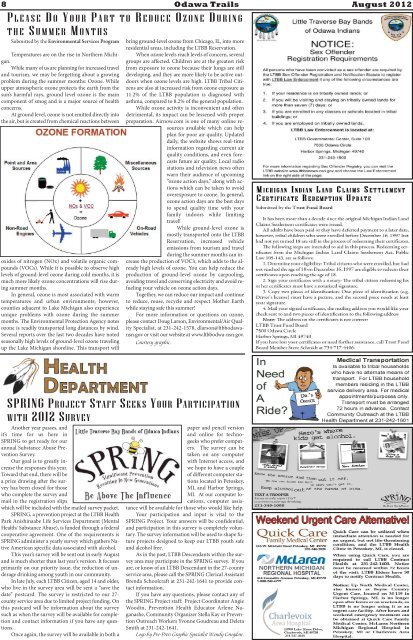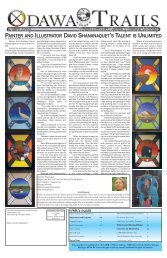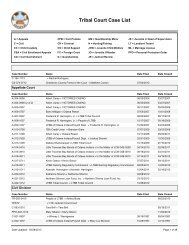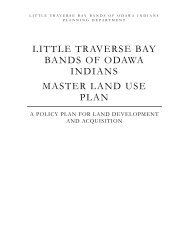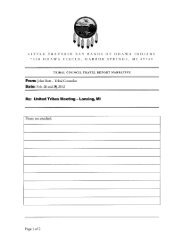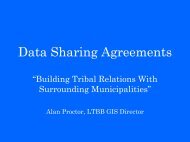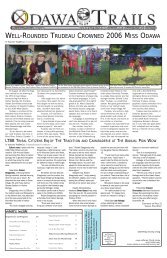August 2012 - Little Traverse Bay Bands of Odawa Indians
August 2012 - Little Traverse Bay Bands of Odawa Indians
August 2012 - Little Traverse Bay Bands of Odawa Indians
Create successful ePaper yourself
Turn your PDF publications into a flip-book with our unique Google optimized e-Paper software.
8 <strong>Odawa</strong> Trails<br />
P LEASE D O Y OUR P ART TO R EDUCE O ZONE D URING<br />
<strong>August</strong> <strong>2012</strong><br />
THE S UMMER M ONTHS<br />
Submitted by the Environmental Services Program<br />
Temperatures are on the rise in Northern Michigan.<br />
While many <strong>of</strong> us are planning for increased travel<br />
and tourism, we may be forgetting about a growing<br />
problem during the summer months: Ozone. While<br />
upper atmospheric ozone protects the earth from the<br />
sun’s harmful rays, ground level ozone is the main<br />
component <strong>of</strong> smog and is a major source <strong>of</strong> health<br />
concerns.<br />
At ground level, ozone is not emitted directly into<br />
the air, but is created from chemical reactions between<br />
oxides <strong>of</strong> nitrogen (NOx) and volatile organic compounds<br />
(VOCs). While it is possible to observe high<br />
levels <strong>of</strong> ground-level ozone during cold months, it is<br />
much more likely ozone concentrations will rise during<br />
summer months.<br />
In general, ozone is most associated with warm<br />
temperatures and urban environments; however,<br />
counties adjacent to Lake Michigan also experience<br />
unique problems with ozone during the summer<br />
months. The Environmental Protection Agency notes<br />
ozone is readily transported long distances by wind.<br />
Several reports over the last two decades have noted<br />
seasonally high levels <strong>of</strong> ground-level ozone traveling<br />
up the Lake Michigan shoreline. This transport will<br />
bring ground-level ozone from Chicago, IL, into more<br />
residential areas, including the LTBB Reservation.<br />
When ozone levels reach levels <strong>of</strong> concern, several<br />
groups are affected. Children are at the greatest risk<br />
from exposure to ozone because their lungs are still<br />
developing, and they are more likely to be active outdoors<br />
when ozone levels are high. LTBB Tribal Citizens<br />
are also at increased risk from ozone exposure as<br />
11.2% <strong>of</strong> the LTBB population is diagnosed with<br />
asthma, compared to 8.2% <strong>of</strong> the general population.<br />
While ozone activity is inconvenient and <strong>of</strong>ten<br />
detrimental, its impact can be lessened with proper<br />
preparation. Airnow.com is one <strong>of</strong> many online resources<br />
available which can help<br />
plan for poor air quality. Updated<br />
daily, the website shows real-time<br />
information regarding current air<br />
quality conditions, and even forecasts<br />
future air quality. Local radio<br />
stations and television news <strong>of</strong>ten<br />
warn their audience <strong>of</strong> upcoming<br />
“ozone action days,” along with actions<br />
which can be taken to avoid<br />
overexposure to ozone. In general,<br />
ozone action days are the best days<br />
to spend quality time with your<br />
family indoors while limiting<br />
travel!<br />
While ground-level ozone is<br />
mostly transported onto the LTBB<br />
Reservation, increased vehicle<br />
emissions from tourism and travel<br />
during the summer months can increase<br />
the production <strong>of</strong> VOC’s, which adds to the already<br />
high levels <strong>of</strong> ozone. You can help reduce the<br />
production <strong>of</strong> ground-level ozone by carpooling,<br />
avoiding travel and conserving electricity and avoid refueling<br />
your vehicle on ozone action days.<br />
Together, we can reduce our impact and continue<br />
to reduce, reuse, recycle and respect Mother Earth<br />
while staying safe this summer!<br />
For more information or questions on ozone,<br />
please contact Doug Larson, Environmental/Air Quality<br />
Specialist, at 231-242-1578, dlarson@ltbbodawansn.gov<br />
or visit our website at www.ltbbodwa-nsn.gov.<br />
Courtesy graphic.<br />
SPRING PROJECT STAFF SEEKS YOUR PARTICIPATION<br />
WITH <strong>2012</strong> SURVEY<br />
Another year passes, and<br />
it’s time for us here in<br />
SPRING to get ready for our<br />
annual Substance Abuse Prevention<br />
Survey.<br />
Our goal is to greatly increase<br />
the responses this year.<br />
Toward that end, there will be<br />
a prize drawing after the survey<br />
has been closed for those<br />
who complete the survey and<br />
mail in the registration slips<br />
which will be included with the mailed survey packet.<br />
SPRING, a prevention project at the LTBB Health<br />
Park Anishinaabe Life Services Department (Mental<br />
Health/ Substance Abuse), is funded through a federal<br />
cooperative agreement. One <strong>of</strong> the requirements is<br />
SPRING administer a yearly survey which gathers Native<br />
American specific data associated with alcohol.<br />
This year’s survey will be sent out in early <strong>August</strong><br />
and is much shorter than last year’s version. It focuses<br />
primarily on our priority issue, the reduction <strong>of</strong> underage<br />
drinking among youth in our community.<br />
In late July, each LTBB Citizen, aged 14 and older,<br />
who live in the survey area will be sent a “save the<br />
date” postcard. The survey is restricted to our 27county<br />
service area due to limited project funding. On<br />
this postcard will be information about the survey<br />
such as when the survey will be available for completion<br />
and contact information if you have any questions.<br />
Once again, the survey will be available in both a<br />
paper and pencil version<br />
and online for technogeeks<br />
who prefer computers.<br />
The survey can be<br />
taken on any computer<br />
with Internet access, and<br />
we hope to have a couple<br />
<strong>of</strong> different computer stations<br />
located in Petoskey,<br />
MI, and Harbor Springs,<br />
MI. At our computer locations,<br />
computer assistance<br />
will be available for those who would like help.<br />
Your participation and input is vital to the<br />
SPRING Project. Your answers will be confidential,<br />
and participation in this survey is completely voluntary.<br />
The survey information will be used to shape future<br />
projects designed to keep our LTBB youth safe<br />
and alcohol free.<br />
As in the past, LTBB Descendants within the survey<br />
area may participate in the SPRING survey. If you<br />
are, or know <strong>of</strong> an LTBB Descendant in the 27-county<br />
service area, please call the SPRING Clerical Assistant<br />
Brenda Schoolcraft at 231-242-1641 to provide contact<br />
information.<br />
If you have any questions, please contact any <strong>of</strong><br />
the SPRING Project staff: Project Coordinator Angie<br />
Woodin, Prevention Health Educator Arlene Naganashe,<br />
Community Organizer Stella Kay or Prevention<br />
Outreach Workers Yvonne Goudreau and Deleta<br />
Smith at 231-242-1641.<br />
Logo by Pre-Press Graphic Specialist Wendy Congdon.


